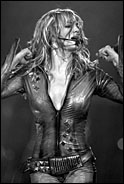A rocking read
Reclining in his chair, his feet resting on his office desk, Will Straw looks like he's about to spin a record and chill for the afternoon.
His easy-going demeanour is almost expected, given that music insiders are rarely uptight, and considering we've gathered in his Arts Building office to discuss his collaboration on a new anthology on popular music. Called The Cambridge Companion to Pop and Rock (Cambridge University Press), Straw co-edited the recently published book with fellow academics Simon Firth and John Street.
A professor of art history and communication studies at McGill, Straw was invited to help lead the project because he's a renowned source on popular music, not to mention a huge fan, owning 7,000 vinyl LPs and countless CDs.
 Pop sensation Britney Spears
Pop sensation Britney Spears |
|
Pop and Rock is the latest in a series of Cambridge companion books and was written to provide some insights into some of the most significant moments in popular music history, from Elvis to the Spice Girls, and contains a chronology of important music industry events from 1877 to 2001.
The book was written by a committee of respected music scholars from across North America and Britain. Each is a noted expert in a different realm of popular music and each has made a special effort to produce an anthology that could be appreciated by academics and music buffs alike.
The book's 13 chapters cover everything from the rise of star profiles in the media to how musical acts have stretched sexual and gender mores.
Straw says the editing team was adamant in not wanting academic musings that would "kill" the spirit of the subject. "An even bigger fear I had in publishing this book," he confides, "was that readers might view it as a nostalgic reminiscence by a bunch of baby-boomers."
No problem there. At 47, Straw is atypical of his generation, preferring dance over rock music. He even sites Aqua, the boppy Scandinavian band best known for its maddeningly catchy hit, "Barbie Girl," as one of his favourite acts.
That's why he helped steer the anthology into covering more than Elvis or the Beatles. "I don't particularly care for Elvis and never have," he notes. "I think his importance has been overstated."
The Beatles are another story. If the group had never existed, Straw says, our musical earscape wouldn't be the same: "The Beatles were a milestone, a group that was special and artistically complex, which allowed them to cross [generations] and belong to everybody."
Both acts are covered in the book, along with a debut chapter on recording technology. That section was written by Paul Théberge, from the University of Western Ontario, and explains how the evolution of mikes, amplifiers and other tools of the trade dramatically altered the way popular music has been recorded and heard.
On top of his editing duties, Straw penned a chapter on music consumption, a chronicle of how we go about obtaining our favourite songs.
He details the way portable radios helped fragment the music industry into many different genres, since families were no longer required to listen to music as a unit around a central radio and could seek out different styles suiting their individual tastes. He also overviews how music consumption continues to change today thanks to second-hand CD shops, megamusic outlets and the downloading of hits off the Internet.
Another consumption issue he tackles is the increasing power of young audiences. Dubbed tweens, they've sparked the explosion of bubblegum pop acts since the mid-1990s: Britney Spears, the Backstreet Boys, N'Sync and a legion of clones.
"This pop boom is being driven by younger and younger audiences, to the point where chains like Toys 'R Us have acknowledged that kids are asking their parents for CDs, whereas they used to ask for toys," says Straw.
Questioned as to whether tween pop will eventually topple, as critics have endlessly predicted, Straw counters the genre will likely live on and coexist with other beats. "The same thing happened when critics said disco or funk were dead," he says. "Instead, they coexist alongside hip-hop, rap and other styles.
"Of course," he continues, "that doesn't mean youth-oriented pop will allow [Britney Spears or N'Sync] to have careers that will last until they are 55 years old."
One music style that Straw says is dying, however, is rock. In most parts of the world and in our increasingly multi-ethnic society, he says, "everyone is looking for beats that aren't found in rock.
"Rock is ethnic music for whites," he adds, pointing to alternative rock concerts as an example. "Only Ku Klux Klan meetings have a higher concentration of white people."
The ailing health of rock, he says, has helped spawn new musical genres.
One was dance music, which Straw overviews in another chapter of Pop and Rock. Since Straw recently completed a history of the 12-inch vinyl, which transformed the music industry in the 1970s and gave birth to the dance music movement, he's become quite an authority on the genre.
He credits American Bandstand with fuelling the initial dance music craze in the '50s by teaching millions of youngsters how to dance to it. As twist clubs went the way of the dinosaur and disco waned, Straw notes that specific types of dance music don't tend to last long, but a new form always emerges to satisfy young audiences' desire to dance in public. Hence the rave.
Regardless of which chapter readers will favour in Pop and Rock, Straw hopes the book gets them thinking: "I like people to examine their own musical tastes and look back to how they acquired them."

